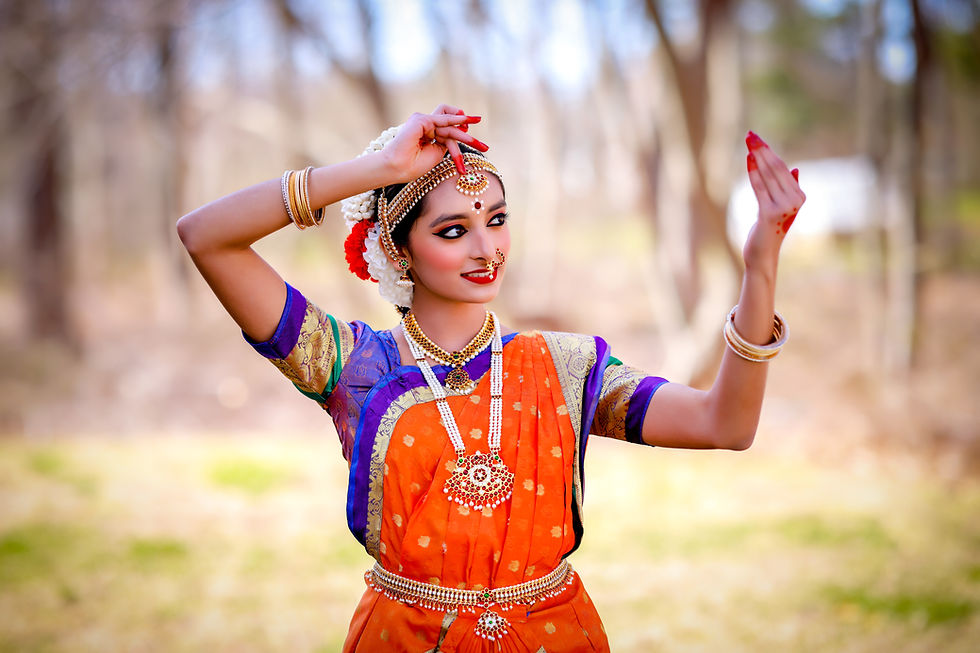.jpg)
Bharatanatyam
The broadly accepted theory on the evolution of Bharatanatyam is that, since Sage Bharata wrote Natya Shastra, formulating the principles of dancing, the dance form is known as Bharatanatyam. It has three aspects to its form, Nritta, Nrithya and Natya. Nritta interprets the rhythmic language through pure body movements. Nrithya depicts facial expressions use to convey the poetic meaning of the dance and Natya uses dance movements to demonstrate dramatic movements. It is the dance of mind and soul and is known for its grace, purity of form and beauty. It uplifts the dancer and the audience to a higher level of spiritual consciousness.
.jpg)
.jpg)
Arangetram
Arangetram (ascending the stage) marks the first qualified dance of an aspiring artist. During Arangetram, the artist performs various Bharatanatyam dance excerpts and exhibits the knowledge she or he gained over several years of dedicated and strenuous training.
Prayer
A traditional prayer is offered to Lord Ganesha, seeking his blessings for the success of the program.
.jpg)
.jpg)
Pushpanjali
Pushpanjali means offering of flowers. The dancer enters the stage with holding flowers in her hands, which are offered to the deity. Here she pays respect to God, Guru and the audience. Pushpanjali is performed with very simple jathis (sequences of footwork).
Alarippu
After Pushpanjali, the performance continues with the Alarippu. It is performed to the rhythm of the drum and cymbals. It is meant to relax the dancer’s body and mind to get prepared to execute the subsequent pieces.
.jpg)
.jpg)
Jathiswaram
The Jathiswaram is another example of a
pure dance where a dancer executes several
patterns to basic musical composition. The
dance is so choreographed as to display the dancer’s brisk footwork, rhythmic coordination and physical grace.
Krishna Shabdam
The Shabdam introduces four lines of poetic text upon which the singer weaves a series of melodic improvisations. It opens up with pure dance and then goes on to an interpretation of the sahitya or literary content. Shabdam means words of praise. This piece is about Lord Krishna. The graceful movements and various facial expressions portray Lord Krishna’s mischievous childhood and how he teased the Gopies.
.jpg)
.jpg)
Varnam
The Varnam is the main item in Bharatanatyam recital in which all aspects of dance are found. It is the touchstone of an artist’s caliber for demonstrating her mastery over footwork and interpretative dance. It is the longest and the most challenging piece. Nritta (pure dance) and Nritya (interpretative movements) alternate through the piece in such a way that the continuous development of a theme is insured. This Varnam is about Lord Muruga, where a devotee asks her companion to go and get him on a graceful peacock.
Ananda Narthana Ganapathim Keerthana
The joyful dance by the noble son of Lord Shiva and Parvati invokes a feeling of unconditional purity and holiness among his devotees. It is well described about
Lord Ganesha for his kindness in this keerthana.
.jpg)
.jpg)
Lullaby
This song represents a lullaby sang to Lord Sri Venkateswara. At bed time, the dames are moving the wings of the cradle with Lord Venkateswara, while accompanied by Alimelumanga and Padmavathi.
Narayana Theertha Tharangam
This piece is a Tharangam composed by Sri Narayana Theertha, captures the devotion that the dancer has for Lord Krishna. In this dance piece, Lord Krishna is described as holding a precious stone called Kausthubham in his heart. He saves the universe by destroying demons. He is fully decorated with precious jewels all over his
body. Interestingly this dance piece ends with the artist dancing on a brass plate and competes by executing rhythmical footwork in conjunction with the guru’s cymbols.
.jpg)
.jpg)
Tillana
The Tillana is designed to introduce variety and rhythmic excitement into the later portion of the program. It usually consists of rhythmic syllables and a few lines of sahitya (text) coming at the end. The Tillana provides a fitting conclusion to a dance recital creating a joyful and exhilaration mood. This is an item with lively beats and alluring poses.
Mangalam
Mangalam is a salutation to the God, the Guru and the audience. Arangetram concludes with this simple piece.
.jpg)
Submit Your RSVP Today

 Sat, Sep 10The Seldin Performing Arts Center
Sat, Sep 10The Seldin Performing Arts Center

